In this blog we’re going to go deep on one of the most important aspects of pickleball – dinking. Specifically dink variety.
Historically the pickleball dink has been viewed as a gentle shot hit from up at the non-volley zone line that is basically just pushed over the net in a gentle arc with not much on it in terms of speed or spin.
A traditional standard dink is hit with an open paddle face and very little swing if you’re doing it right. You just kind of bump it over the net.
In some key ways, that style of dinking is still applicable, but dinking has certainly evolved over the years and we’re going to explore that in this blog.
We here at primetime pickleball have developed somewhat of a reputation for advocating hitting with spin on the majority of your dinks, if you’re capable of doing so.We certainly admit to that but we are not against no spin dinks. Also known as flat dinks.
So how can both of those things be true?
We are for spin on just about all dinks but we are not against flat disks. Well the answer, as is true with so many things in this great game of pickleball, is that it depends on the context. And, in this case it really depends on the level of play we’re talking about.
The reasons for using flat dinks at different levels of play is very different and practically totally unrelated.
Hang tight, this will all become clear as we go along.
We’re diving deep here on some advanced and nuanced topics. Let’s break it down. Here is a brief overview of the two scenarios in which we advocate the use of flat dinks and we’ll dive deeper on each of them shortly.
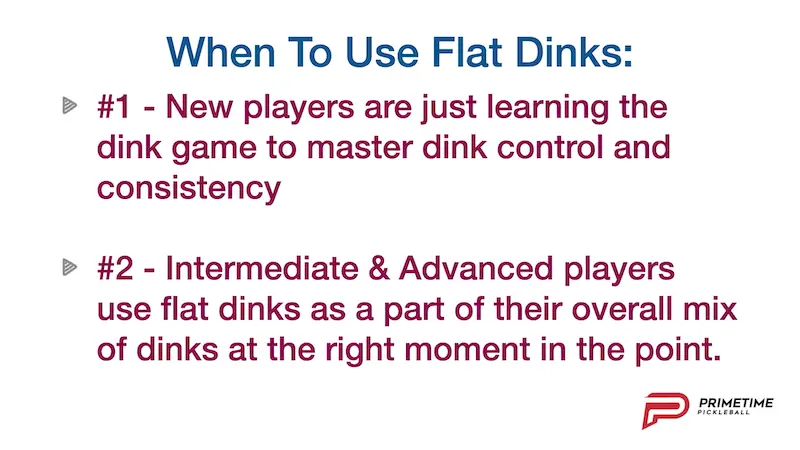
Scenario number one: We’re big fans of players that are just starting out learning the game using flat dinks practically exclusively.
Scenario number two: We’re fans of advanced players using flat dinks as part of their overall mix of dinks in very specific and particular situations of a point. More on what those situations are a bit later.
Let’s take a deeper look at scenario number one. Players that are just learning the game.
Soon after you learn the basics of how to play pickleball such as how to serve, return, and keep score, you will learn that dinking is an important part of the game. It’s something that you will want to learn and do as part of a winning strategy.
Unless of course you decide to try your luck at what we call banging and go with that strategy for as long as you possibly can because you greatly prefer hitting hard and it seems to be working for you for now. That’s fine. But, at some point you will hit a ceiling with that strategy and have to learn how to dink. It’s practically inevitable if your desire is to be the best player that you can be.
So let’s say we’re learning how to dink for the very first time or we’re teaching someone to dink for the first time. Two players are up at the non-volley zone line dinking. If at least one of those players is an entry-level player, both players should be dinking flat with no spin. The direction should be back and forth to each other in a cooperative manner.
To start they’re really just getting a feel for a dink and have a fixed target goal which should be directly towards the other player in front of them. They should dink in such a way that it will bounce well in front of the other player and reach them comfortably after a bounce.
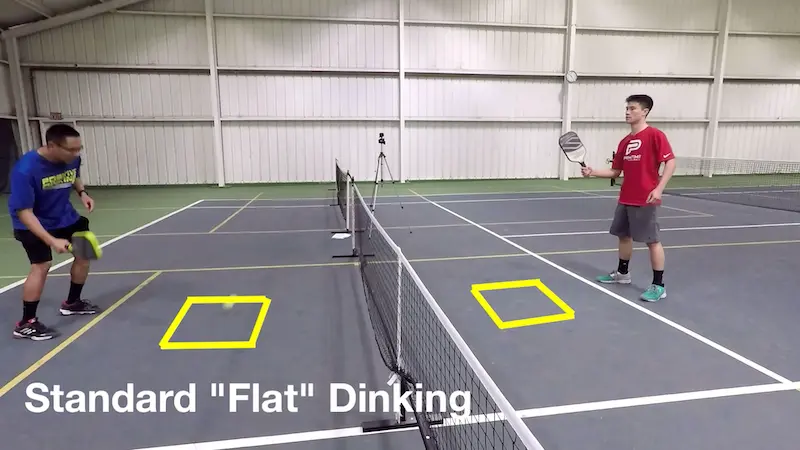
Flat dinks are the easiest to understand and hit which is why everyone should start with those when they’re just learning how to dink. If you have one player that is an experienced player teaching a starting player, even if that experienced player knows that it dinks with spin, they should still hit flat dinks to the beginning player because not only are flat dinks the easiest to hit but they are also the easiest to receive. This is the case because they bounce true and in a way that you expect and can predict.
They will not veer off in an unexpected way after the bounce and the flight of the ball in general will be straight. Once a new player is able to consistently hit flat dinks back and forth with another player across the net from them, the next step is to start moving that flat dink around the kitchen, in a lateral manner, towards the sideline and also towards the middle of the court (If you’re dinking on only one half, as you typically will be with two players).
Both players can start to gently and intentionally start moving the ball around the kitchen so that both can get a feel for having to get to a ball that is hit slightly away from them, get set, and then successfully hit the ball to the target they intend.
Look we’re not talking about hardcore placement and movement from sideline to center line, hustling hard back and forth, having to run. Just a bit to the left or to the right of the player so that they have to take one or two extra steps and no more. Set it up in such a way that the ball is not coming directly to them. It’s just a little bit off to one side of them or the other.
After that’s going pretty well, next, new players can work different depth targets. Deeper in the kitchen and short in the kitchen. Once you get comfortable moving a flat dink around the kitchen at will, both side to side and up and back, you’ll really start to get somewhere with the dink game.
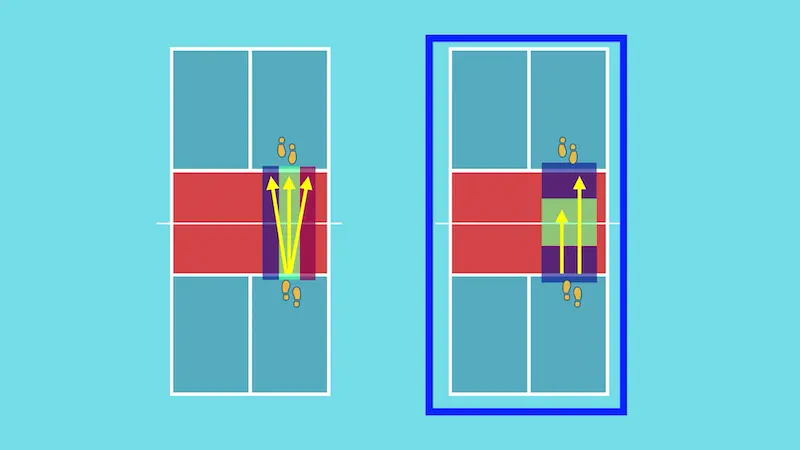
Everyone should go at their own pace to get to this level while working on it diligently. Some will pick this up quickly and others will do so more slowly that all depends on so many factors that are way too many to get into here and they’re really not that important.
The point is that before you can advance to what we’re going to talk about next you must be able to comfortably move a flat dink around the kitchen with control even when you are a bit on the move on your side of the court.
That more or less covers the first scenario in which we recommend using a flat dink.
Let’s move on to scenario number two and we’re gonna set the stage for that scenario right now.
The purpose of the dink in the modern game is to execute a three-step process.
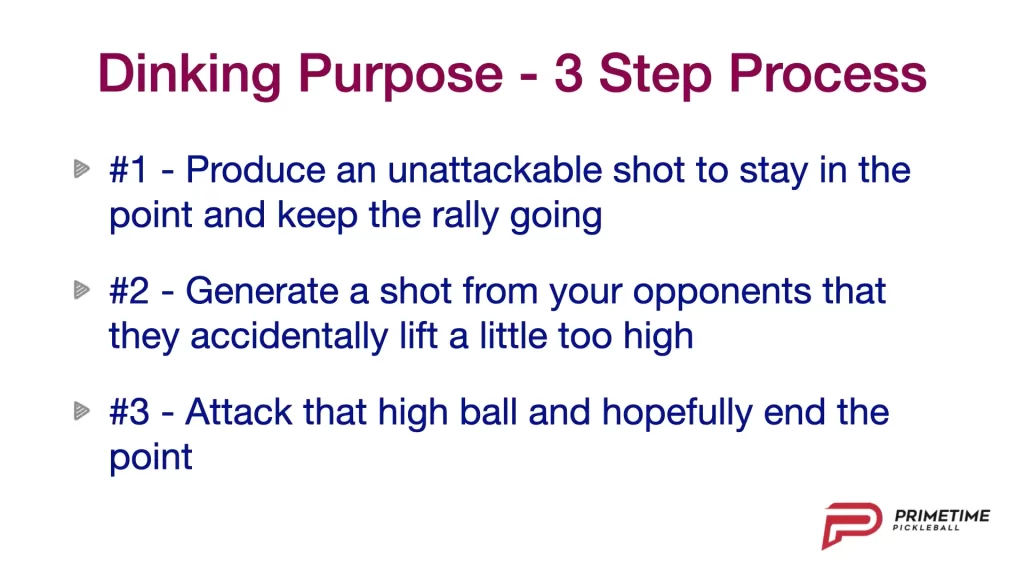
Number one, produce an unattackable shot to stay in the point and keep the rally going.
Number two, generate a shot from your opponents that they accidentally lift a little too high.
Number three, attack that high ball and hopefully end the point right away or soon thereafter.
The problem with the beginner flat dink we’ve been talking about until this point is that it already falters at step number one.
Here’s why.
A traditional flat dink bounces a bit higher than we would like. In today’s game players are getting more and more comfortable and adept at attacking balls that are somewhat below net level height. And, a flat dink can have a tendency to bounce within an attackable range.
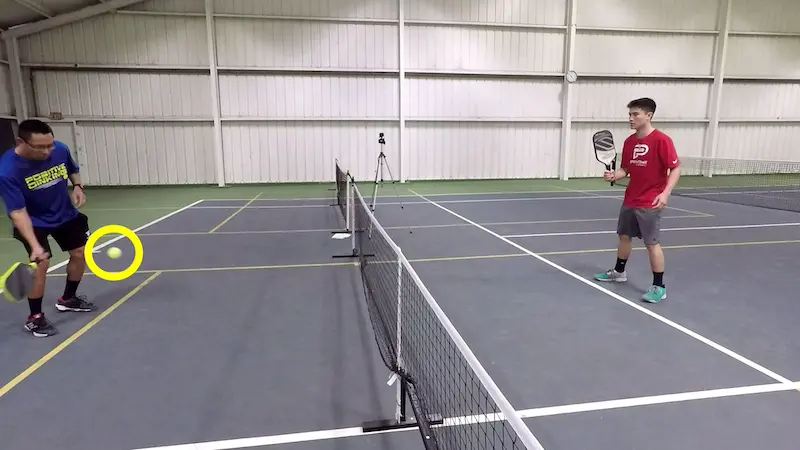
That is a problem and that’s where spin dinks come in.
Specifically the first spin dink you should learn is the sliced dink, also known as the underspin dink. The underspin dink solves the high bounce problem. Underspin will cause the ball to die or skid a bit after the bounce and hence keep it low.
It’s definitely a learnable skill to hit consistent sliced dinks that stay out of the attackable range. So we’ve solved step number one with a slice dink.
Now we can move on to step number two. Generate a shot from your opponents that they accidentally lift a little too high.
Flat dinks don’t do so well at this stage either because instead of generating a shot from your opponents that they accidentally lift a little too high, all you can do is wait and hope because flat dinks don’t really press your opponents that much.
Sure, you can and should, move it around from side to side, as well as shorter and deeper. But, beyond a certain level that’s just not going to be enough pressure to cause a lift.
Slice dinks can also help us here at step number two. In addition to location variety, you can mix in underspin to really mess with your opponent’s timing.
As we mentioned, underspin will skid a bit. It will skid a bit more or a bit less depending on how much spin you put on the ball. That, in combination with location variety, will probably eventually cause a misjudgment by your opponent and produce a miss or a lift that comes back too high.
This brings us to step number three – you pounce on that ball and attack it for the finish.
What you can do to really stack up the pressure on your opponents is to start to also learn and mix in top spin dinks. Topspin dinks will hit the ground and bounce forwards towards your opponent. That messes with their timing even more.
They will constantly have to adjust to your shots that you are moving all over the kitchen, while at the same time causing a lot of uncertainty as to how that ball is going to react after the bounce, since you are now mixing in slice with topspin dinks.
The potential to produce a pop-up increases dramatically once you combine all these varieties together.
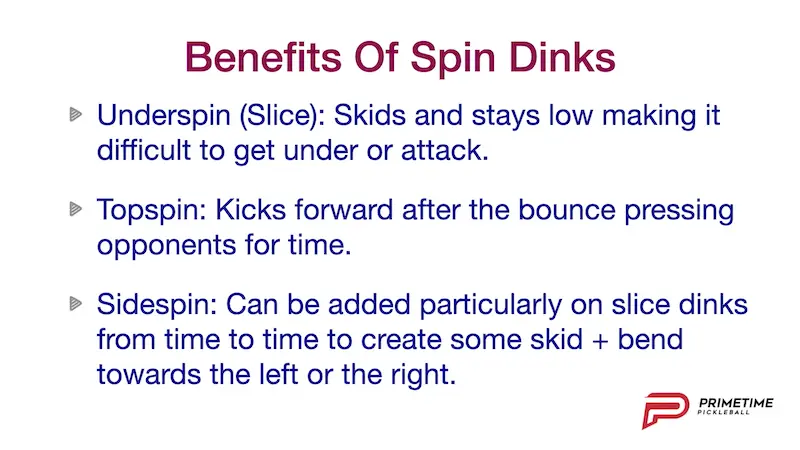
These additional benefits is where spin dinks come in super handy particularly towards achieving step number one and number two.
Flat dinks go almost entirely out the window because spin dinks just work so much better to both keep your dinks unattackable and press your opponents in order to produce that pop-up.
The key word there is “almost”.
Here’s how you’ll want to mix flat dinks back into the equation.
In order to put any kind of spin on the ball, whether that be under spin, side spin, or top spin, you need to have a little length on your swing.
Not a whole lot really, but some. Just enough so that you can actually impart that spin onto the ball. It’s virtually impossible to put any meaningful spin onto the ball without some length of motion to your swing.
Flat dinks are very different.
In many cases you can literally just bump it. Or, it can also be thought of as just nudging the ball. A dink with no spin allows for the least amount of arm and paddle motion. You certainly can have a more pronounced swing on a flat dink and hit it firmer but the point is that you don’t have to like you do with a spin dink.
Also, when you hit a flat dink, you have the most amount of contact with the ball and are hitting the most through it. So, you can usually get that ball moving faster through the court because of this.
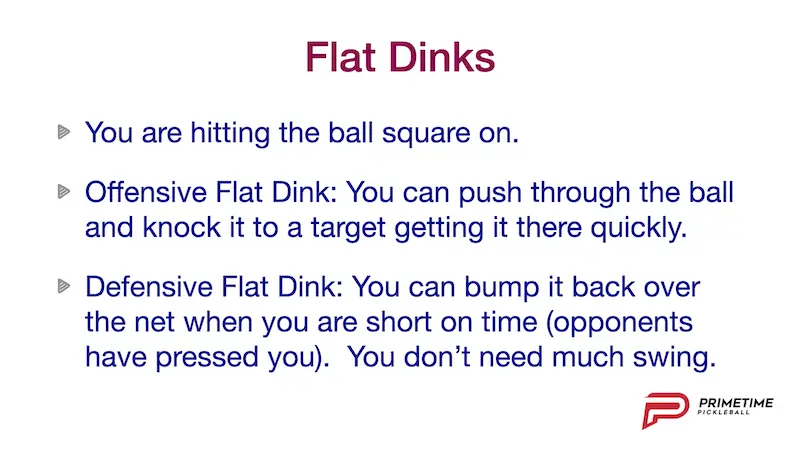
On spin dinks you’re cutting the ball and making overall less contact with it because you aren’t hitting perfectly through the ball. You’re not hitting it totally flush and square. As a result you can’t get it moving through the court as fast as you can with a flat dink.
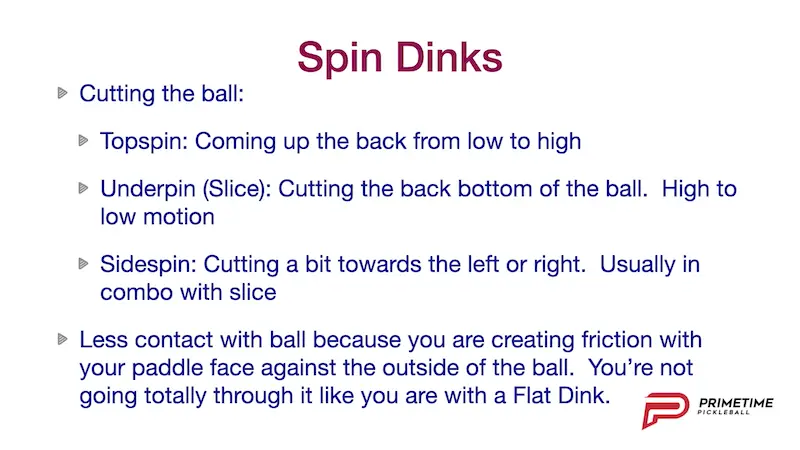
Because of this, flat dinks afford you the opportunity for the ball to be with you for the least amount of time.You can send them off the fastest because they require the least amount of time to hit since they require the least amount of motion.
Also, you can get them traveling faster through the court than dinks with spin.
The benefits of flat dinks we just described are convenient at two particular times. Number one, when you’re short on time and space. And number two, when you want to make your opponents short on time and space.
There are times where your opponents will jam you and rush you. They will hit it near your feet or even try to get it low and behind your feet.
You won’t have a whole lot of time to get out of the way to create enough space to do with the dink what you would like to do. You need to get out of a literal jam, so to speak, and it’s very doable. But, you’re short on time. You don’t really have the luxury on this shot to be dinking aggressively and hitting your spin dinks.
In fact, at this point, you’re on the light defense and are seeking to avoid any real damage that will come on the very next shot from your opponents if you don’t deal with this one correctly. This is the perfect, and in fact necessary, time to use a flat dink to just block it and bump it back.
Often this will be done as a half volley. A half volley is a shot that you contact right after the bounce because you have to. It’s just barely started its ascent to the peak after the bounce and you will need to hit it right then and there to prevent the shot from getting any further on top of you than it already is.
Your best bet is to hit a half volley dink and just bump it back low over the net landing in the kitchen. You’re essentially hitting a defensive or neutralizing dink and that is okay.
It’s not red alert defense but you are in a bit of a bind. You should be able to get out of it if you handle it correctly. Most strong players are able to deal with these shots successfully most of the time.
You need to get good at these if you hope to be a strong player. Learn to hit a flat blocking half volley defensive dink. It has to be flat because you just don’t have time for it to be anything else.
Conversely the exact scenario we just described is what you want to do to your opponents to increase the likelihood of a pop-up from them.
As we mentioned, if they are strong players they will often be able to deal with it. But at higher levels, games are won and lost on those few times when they weren’t able to deal with it correctly and you won the point as a result.
Teams that can stack up more of those few and far between, but still ever present, errors, win. So, if you see an opportunity to hit a deeper dink right at your opponent’s feet or even behind their feet, low, into one side of them or the other, do it. And you need to get it there quickly.
Use a flat dink if you can to knock it there so that it gets there as quickly as possible. This works when you can contact the ball relatively high (these opportunities certainly do present themselves).
However, for those times when it bounces a bit lower than you would like (which are sure to happen especially after a bounce) then you may need to put a little topspin roll on it to help with net clearance. But if you can, knock it there flat, so that it gets there fast.
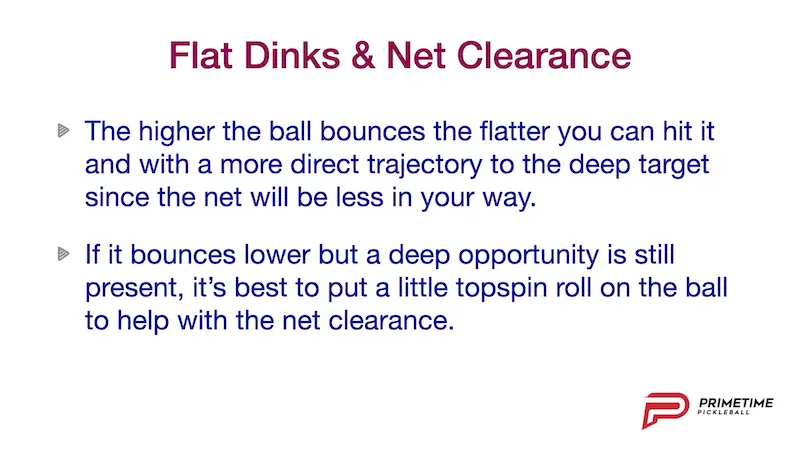
Lastly you can mix in flat dinks between your spins from time to time to give them something that they may not have seen in a long time. Maybe you’ve been hitting lots of spin and now they’re used to receiving that spinning ball. Push a flat dink at them to keep them honest and see what happens.
I can’t tell you how many times I feel that I’m just doing a fabulous job of mixing and spinning the heck out of the ball and my opponent is handling it. Sure they’re working hard but they’re locked in on it and not missing.
So, I say to myself – “Here, here’s a really basic dink that you haven’t seen in quite a while that’s way easier than anything I’ve been giving you” And you know what? It surprises me how often that easier one gets missed simply because they’re out of rhythm on those particular types of dinks even though technically it’s the easiest dink they’ve seen from me in a while.
It’s not that it’s hard to handle it’s just that they’re out of rhythm on it which is why it works. There’s also the added bonus of them getting extremely frustrated with themselves for having missed that dink out of all the dinks that they’ve just received which have mostly been much harder than that one.
In this blog we focused primarily on dinks after a bounce but all of the same logic applies to volley dinks as well.
In fact, more so because when you volley dink, you can often get a higher contact point than a dink after a bounce. Therefore, that extra height will give you a better chance at having a more straight trajectory to your target over the net which gives you the opportunity to hit it flatter.
You certainly can, and should, be mixing in tons of volley dinks between dinks that you let bounce.
In fact, you should actively be looking to take as many dinks as the volley as you can.
Volley dinks will take more time away from your opponents, which, as we mentioned, is definitely something you should be looking to do at all times. This mentality also ensures that you are staying up as close to that line as you possibly can and aren’t letting any attacking opportunities slip through the cracks.
So, there you have it. That’s the long and the short of why we strongly recommend that you learn how to put spin on your dinks if you hope to maximize your success on the pickleball court and use flat dinks at the key times that we mentioned.
Always remember that pickleball solutions are not black and white. There’s so much gray area and nuance to play around with. That’s a big part of what makes the sport so fun and challenging.
We hope that this has really helped you to see how you can use all types of varieties in your dinking. In fact, you must do so if you hope to stay competitive. We hope this definitively answers the question of – to spin or not to spin?
The answer is to learn them both and use them each when the time calls for it.